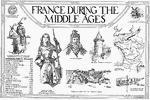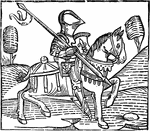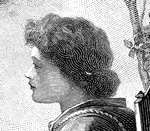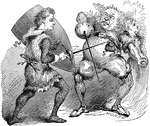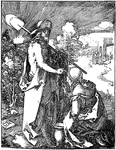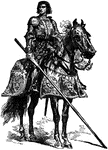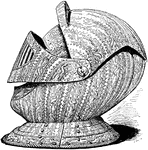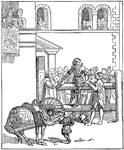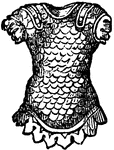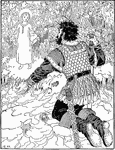
The Selfish Giant
From the book of stories by Oscar Wilde, The Selfish Giant is about a giant who closes his garden up…
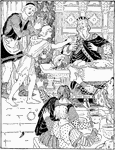
Roland
A legend of the knight Roland, who fearlessly claimed his rights by taking food and drink straight from…
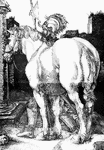
The Great White Horse
"The Great White Horse. By Albrect Dürer. From the engraving on copper." -Heath, 1901
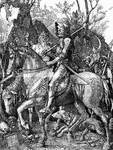
The Knight, Death, and the Devil
"The Knight, Death, and the Devil. By Albrecht Dürer. From the engraving on copper." -Heath, 1901

The Knight and the Lady
"The Knight and the Lady. By Albrecht Dürer. From the engraving on copper." -Heath, 1901

A Knight of St. John
It takes its origins from the Knights Hospitaller, an organization founded in Jerusalem in 1050 as an…

Sir William Wallace
Sir William Wallace was a Scottish knight, landowner, and patriot who is know for leading a resistance…
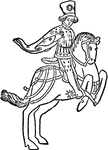
Squire
In feudal or medieval times a squire was a man-at-arms in the service of a knight, often as his apprentice.…
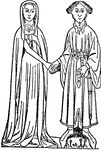
Squire and Wife
An illustration of a squire and his wife. In feudal or medieval times a squire was a man-at-arms in…

Squire of a Knight of the Bath
An illustration of squire of a Knight of the Bath at the crowing of Charles II.

Knight and Captive
An illustration of a knight holding a prisoner with one hand and a sword with the other.

Fluted Dossière
"In armor, ornamented with ridges, corrugations, and the like, which in some cases added also to the…

Weston Coat of Arms
"The male figure is that of Sir John de Weston, of Weston-Lizars, in Staffordshire, and Isabel his wife,…

Chaplet
"Argent, a chaplet proper. CHAPLET. An ancient ornament for the head, granted to gallant knights for…
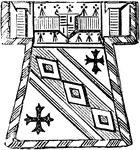
Coat Armour
"COAT ARMOUR, or Surcoat. A loose garment worn over the armour of a knight; hence the term coat of arms.…
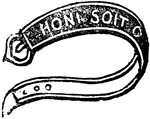
Garter
"GARTER. The insignia of the most noble order of the knights of the garter. It is formed of blue velvet…

Open Helmet Direct
"The helmet without bars, with the beaver open, standing directly fronting the spectator, denotes a…
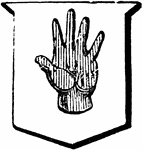
Knight and Baronet of King James I
"KNIGHT AND BARONET. A degree of honour next to a baron, created by King James I. to induce the English…
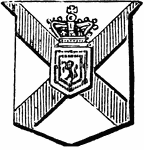
Knight and Baronet of Nova Scotia
"KNIGHT AND BARONET OF NOVA SCOTIA. A new creation during the reign of George I. to induce capitalists…

Pennons
"PENNONS. Small flags borne at the end of a lance of an esquire or gentleman bearing his paternal arms.…
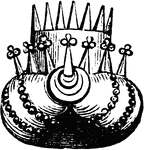
Turband
"TURBAND. In coats of arms, where the knight was a Crusader, this figure often appears. It was the form…
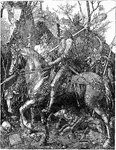
The Knight, Death and the Devil
The Knight, Death and the Devil is an engraving that was created by German artist Albrecht Dürer…

Knight Riding Horse & Holding a Lance
An illustration of a knight riding a horse and holding a lance.
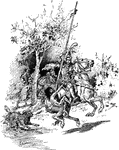
Knight Riding Horse with a Child Holding onto Knight
An illustration of a knight riding a horse and holding a javelin with a child holding onto the horse…

Two Knights Jousting with Lances
An illustration of two knights jousting with lances, shields, and armor.
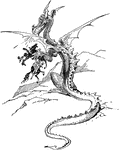
Dragon Holding Knight & Horse in Claw
An illustration of a dragon holding a knight and a horse in his claw.
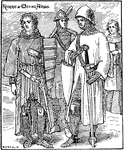
Fourteenth Century Knight and Men at Arms
An illustration of a knight and three men at arms wearing iron armors during the fourteenth century.

Knight Tournament from Romance of King Meliadus
An illustration of fourteenth century tournament of knights wearing armor from Romance of King Maliadus…
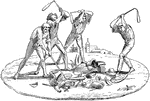
The Destruction of Feudalism
"A contemporary cartoon representing the French people hammering to pieces with their flails all the…

Arming a Knight
"At the age of twenty-one the squire became a knight, being then introduced to the order of knighthood…

Ignatius of Loyola
A Spanish knight who founded the Society of Jesus and was its first Superior General.
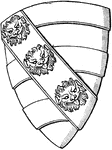
Heraldic Shield with a Lion's Face
The shield of a knight of the time of Edward II. The lion's face is a common charge in heraldry.

Helm of Baronet
"The Helm of Baronet and Knights is of steel, garnished with silver, and standing affronté; the…

Gauntlet
The Gauntlet is a piece of protective armor for the hand, dating back to the 12th century. The first…

Allecret Armor
A knight wearing Allecret armor, which was typically worn by the Swiss in the 16th century.
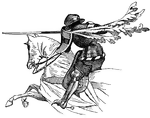
A Knight on Horseback, Wearing a Woman's Sleeve as a Favor
Illustration of a knight, riding a horse at full gallop, carrying a javelin and wearing full armor.…


